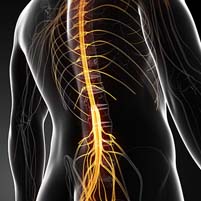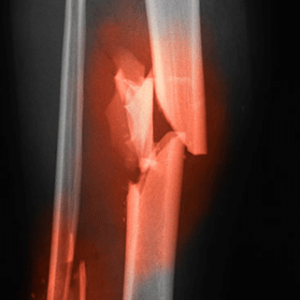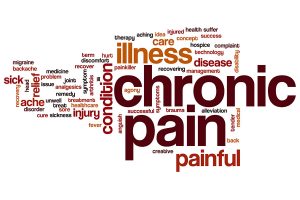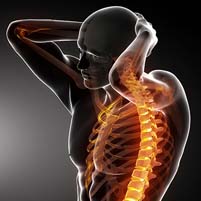A life without pain seems like a dream come true for people who suffer from chronic pain. However, pain is essential to protect you from harm. It acts as a warning signal to make you change your behaviour and prevent harm to your body. Pain can act as a warning signal in our everyday activities. If you test the temperature of a hot shower, pain will tell you if the water is too hot and may burn your body. Pain protects you from harm, or more accurately possible pain saves you from actual harm. Find out how acute pain differs from chronic pain.
What is pain?

The International Association of Pain (IASP) defines pain as: “an unpleasant sensory and emotional experience associated with actual or potential tissue damage”
Let’s break that down:
- Unpleasant = it sure is
- Sensation = physical feeling
- Emotional = how do you feel about this physical sensation?
What is your reaction to this physical sensation?
- Actual = real harm that happens now
- Potential = possible harm that may develop
In South Africa more than 48% of people suffer from chronic pain, that is a whopping 24 million people (Smuts, 2008). More people suffer from chronic pain than heart disease, Diabetes Mellitus and cancer combined (Tsang et al, 2008).
How do we measure pain?
Pain is subjective and therefor the experience of pain is different to each person. Each of us has a different relationship with pain. How you were raised, your own past experiences and the behavior of loved ones suffering from pain, influences this relationship. Therefore, each of us will react differently towards pain.
The visual analogue scale (VAS) measures pain intensity. You pick a score between 0 – 10 that best describes your pain. Unlike other objective tests we as physios can use to determine how severe your injury is, we cannot climb in your body and feel what your pain feels like to you. There is no wrong or right answer. Pain is always subjective to yourself and your own experience.
0 /10 = no pain at all
10/10 = worst pain you have ever felt.
During your treatment the VAS score is used. It is a baseline to work from, but is not the only factor we take into account when treating you. Was there a difference in your pain intensity? But also was there a difference in your ability to do what you need to do? Pain is considered, but function in life is even more important.
Could you sit for longer, could you shift gears easier, could you pick up or play with the kids? These activities are all important in your journey to recovery. You can expect to fill out questionnaires about this. Again so that we have a starting point to work from, in order for us to monitor changes in your activity, movement and pain. The VAS and questionares allow us to establish if we are progressing or regressing.

Why do we experience pain differently?
You are conditioned as a child to react to pain. Makes sense? If you watch toddlers playing with their parents close by, you might have noticed that in the event of a knock to the head or a trip and fall, their first reaction is rarely to start crying spontaneously. They immediately turn to their parent, awaiting a cue for what their response should be. If Mum or Dad brush it off as a silly incident and say don’t worry you are fine, toddler gets up and go. If Mum makes a scene….toddler cries. These first incidents will have an effect on how you experience and deal with pain in your adult life.
Acute vs Chronic Pain
Acute pain physiology

The process is a bit different for acute versus chronic pain.
Acute pain is pain of recent onset and probable limited duration. It usually has a direct connection to injury or disease. This will be the pain you experience after spraining your ankle. You stepped skew, felt a sudden pain around the outside of your ankle. There was some swelling. Initially it hurts to walk, but as time went on you could walk without limping. As the tissue healed, your pain decreased and then disappeared. That is a normal response to injury and pain.
Three parts of the nervous system have almost simultaneous actions in the processing of the experience.
- Brain (central)
- Spinal Cord (central)
- Periphery (the rest of the nervous system)
The nociception route / pain pathway
To understand the experience we have to follow the stimuli’s route all the way from the extremities to the brain. All nociceptors, despite their function have a firing threshold. Not all messages reach the brain. You could compare that to a cascade. If the ball doesn’t drop in the right place, the rest of the cascade won’t happen.
The dorsal root reflex (DRR) deals with impulses below firing threshold, without involving the brain. These messages “backfire” back to the extremities and cause neurogenic inflammation. This process is generated by the nerve itself and causes sensitization. Adequate activation of the DRR can lower the firing threshold in that particular area. That will make the nerve more responsive to other stimuli.
The speed of different types of nociceptors
Nociceptors also work at different speeds. We have thinly myelinated nociceptors (A delta fibres) and unmyelinated nociceptors (C fibres). The myelin sheath protects the nerve and increases the speed at which the nerve can function. A delta nociceptors is like a fibre connection, and C nociceptors are like dialup.
If the stimulus is enough to reach the firing potential your body will not pay attention to it.
From here the message travels to the spinal cord. This is a very busy intersection where some previous experience comes into play. If the stimulus is important enough to reach the brain. Let’s take the example of bumping your toe. First reaction: “ouch!”, second reaction: look down to see what is going on. This quick self assessment will either let the body heighten the importance of the injury, if there is blood or a rusty nail through your foot. And with good reason, because in these events you definitely need help. But if you see there is no threat, you will probably forget that you bumped your toe in half an hour.
Chronic pain physiology
If you get long term, sustained input from the nociceptors this can lead to sensitisation. Almost like when your neighbour’s dog bark each night. The first night you can handle it, the second night you are irritated, the third night you can’t sleep at all. Nerves can also get irritated, we just call it sensitised. Long term sensitisation can lead to:
- Allodynia: experiencing pain from normally not painful stimuli, like your clothes on your sunburnt back.
- Hyperalgesia: it feels as though the pain is spreading.
- Referred pain: pain is felt in an area that didn’t get injured. Most people think this is due tocompensation, but it actually happens because the neurons converge and almost melt together. Thats why people with chronic pain struggle to pinpoint where is started.

Pain and tissue damage
Pain does not always equal tissue damage. Take ‘phantom limb pain’ as an example. This is pain felt by an amputee in the amputated limb. There is no limb, but there is pain. How can that be? Or you are feeling fine after you scraped your knee, then someone says to you: “ouch, you’re bleeding, that’s got to hurt”, suddenly there is pain. How do you explain that?
Different nociceptors
To understand this, we have to delve into the physiology behind the experience of pain. You do not have one single “pain receptor” in your nervous system. What you do have are loads of nociceptors. Nociception is the transmission of noxious stimuli in the body through the nervous system. Noxious stimuli is potentially harmful messages sent from the body to the brain. Different nociceptors carry different messages.
Thermal nociceptors:
These are sensitive to temperature change in the body/surroundings, from the skin and eyes.
Mechanical nociceptors:
These are sensitive to stretch/load and found in joints, tendons, ligaments and muscles.
Chemical Nociceptors:
These are sensitive to change in pH of the body, which can happen as a result of an inflammatory reaction, they are widespread in the body.
What does nociceptors do?
Nociception is the relay of a potentially damaging stimulus to the tissues. It is more of a “warning”, than a “announcement”. “Please remove your finger from the flame, it may burn”, than “your flesh is melting away from your bones and turning to charcoal”. Nociception is extremely important to protect you from everyday unslaughts from the world, like the pain of new shoes chafing your heel.
Remember ignoring a warning can lead to actual problems. Do you ever ignore the flashing light to check your car’s engine? No, so why then with pain? If you are unsure if what you are feeling is serious or not, rather have it checked out. We will be able to help you.
Nociception is a message in your inbox, a warning, while pain is the action your body forces you to take to make you stop the damaging or potentially damaging behaviour. This may be running or sitting in front of your computer.
This experience may be influenced by a lot of things, very specific to each individual:
- previous experience
- loved ones or acquaintances that may have had the same problem
- who you consult with first
- were your questions answered by the people you consulted
More times than not you feel anxious because of your pain experience. Thoughts that might be racing through your brain:
- What is wrong?
- How severe is this damage?
- Can I make it worse?
- What should i do to help the healing process?
- What should i avoid to help the healing process?
- Will i be able to do what i am supposed to daily? (work/cook/drive/carry the kids/train)
Is my pain in my head?
You cannot experience pain without a brain. A person in a coma cannot experience pain. Pain is a result of a conscious mind, previous experience with a similar event and the fears and worries that accompany the event.
If any of these processes are disturbed, acute pain can turn into chronic pain. The old school definition of chronicity only took duration of the pain experience into account. Recent school of thought advocates that chronic pain is not distinguished by its duration, but the “body’s inability to achieve normal physiological homeostatic levels” after injury (Loeser & Melzack, 1999).
Chronic pain is real. It is not “in your head” in the crazy roll your eyes and point to your head kind of way. It is in your brain, way longer than it is in your torn ligaments or disc bulge. The pain is there, despite the tissue healing.
Why does this happen?
This happens when all of the acute pain “events” are maintained.
- Peripheral sensitisation is maintained, because the nerve is continuously generating inflammation.
- Spinal cord sensitisation (irritation) is maintained together with all the side effects (allodynia, hyperalgesia, referral).
- Brian changes can cause an actual loss of grey matter, visible on an MRI. Changes can further lead to a change of your body’s map in your brain. Now the previously injured area is taking up all the space. It is all consuming. You may feel as though you are forgetful, emotional or even experience a change in your personality. It is not in your mind, it is in your brain. There is hope, noninvasive (no surgery) treatment to change your brain again.
We strive to treat the source of the pain. Recent tissue damage causes acute pain. We will treat the injured area. We make use of different techniques that a suitable for your specific injury. Treatment will be mostly hands on with a few things that you can do to hasten the healing process at home.
We have established that chronic pain is not the result of tissue damage that happened now. The initial injury might have happened years ago. Your body has the ability to heal itself. We expect that the damage has healed. But the brain, spinal cord or extremities are now keeping the noxious stimuli going. We need to treat the source of the problem, or it will not go away.
You can expect a lot of talking during your consultation. We need to make sure that you understand what is going on in your body. Then we can treat the brain. Re-wire it, to stop maintaining the unnecessary pain experience. We will attempt the re wiring with graded motor imagery. This is a relatively new treatment approach with 3 different stages. Everyone moves through the stages at their own pace. We aim to stop the malfunctioning of the entire nervous system.



